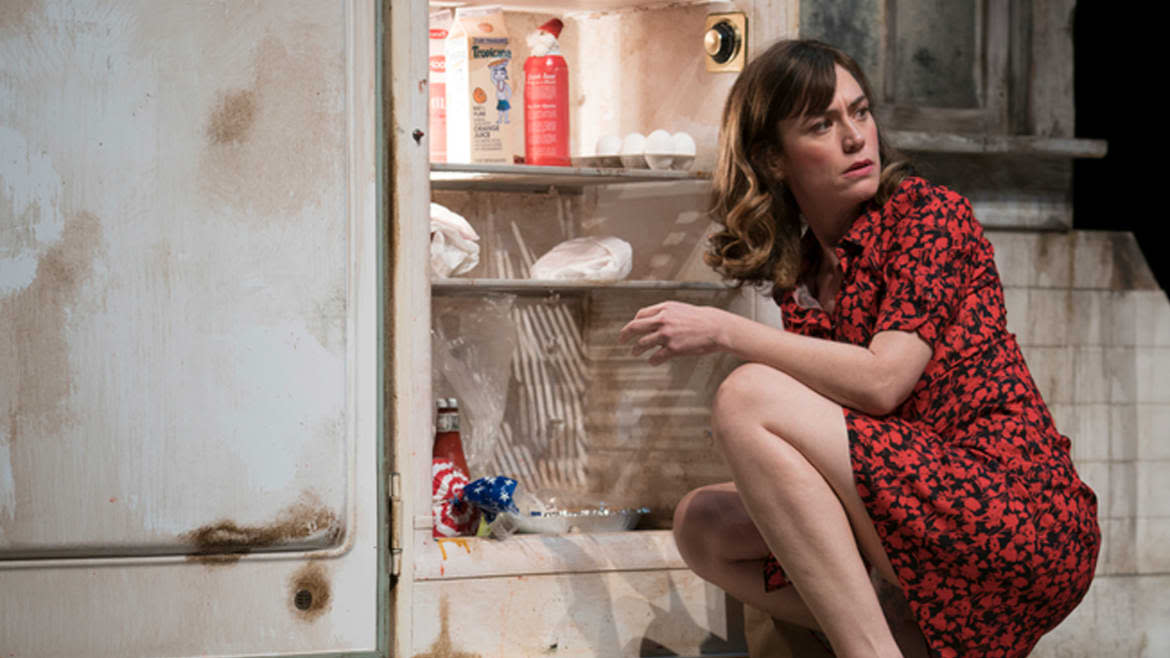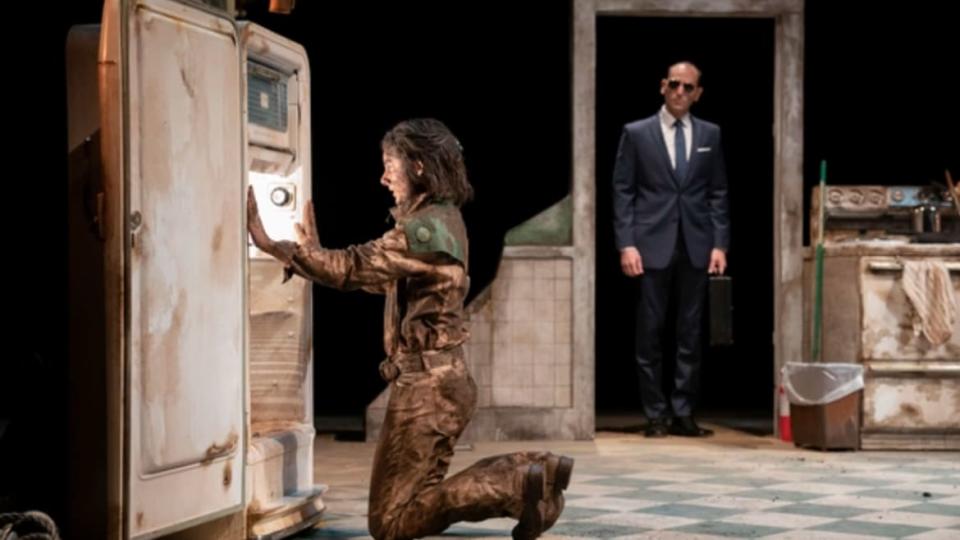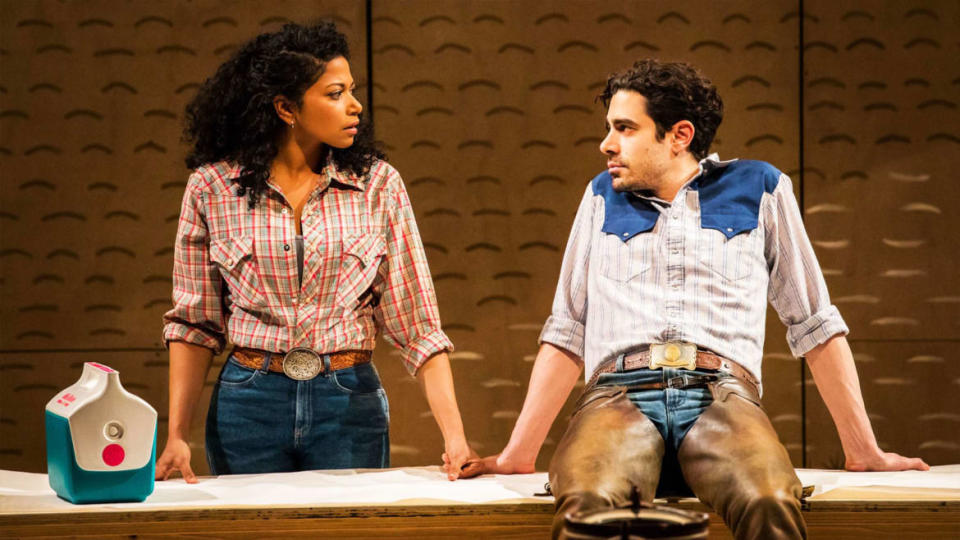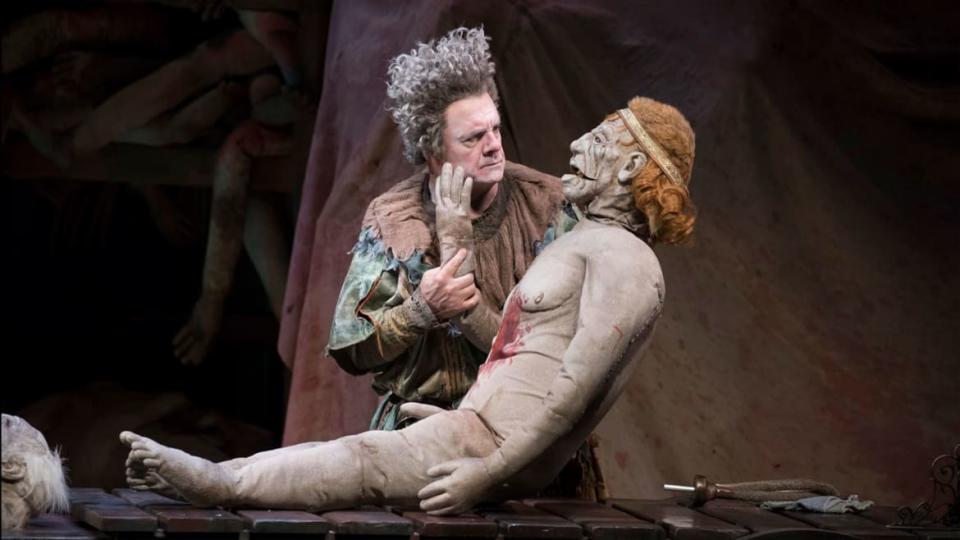Tear It Apart, and Pile The Bodies High: Theater Designers Reveal How To Shock On Stage

It’s not often, before a word has been spoken or an actor appeared, that the scenery of a production gets a loud round of applause, but not every stage design is as shocking as Julian Crouch’s for the Signature Theatre’s production of Sam Shepard’s Curse of The Starving Class. (Warning: spoilers ahead. Stop here if you want to see this show and be surprised.)
You sit down inside the theater, and you’re facing what looks like a well-constructed, scuffed, Shepard-y domestic interior.
This Is How Sam Shepard Revolutionized Theater
Then, suddenly, the set self-destructs in front of you in an astonishing series of wrenches and cracks. Walls and cupboards split open, utensils and plate topple and hang, the entire interior of the house ends up in tattered suspension.
And then the play begins, and the set stays that way.
“Sometimes I get a little embarrassed when the applause happens. It’s not what I’m going for,” said a humble-sounding Crouch. “I wanted something to raise the stakes, but I didn’t want the applause.”

'Curse of The Starving Class'
Crouch’s isn’t the only stunning stage design currently on view in New York (and these designs work in conjunction with their productions’ sound and lighting designs). On Broadway and in Tony contention, Laura Jellinek’s design for the Broadway revival of Oklahoma! is a brightly lit blank canvas of plywood, with guns in mounted cases on the walls, and audience members watching in full view of the actors and each other.
For Taylor Mac’s Gary, the also Tony-nominated Santo Loquasto imagines the scene after the end of Titus Andronicus, with hundreds of bodies and limbs piled grotesquely and comically high around the actors, who scale them as if mini-hillocks. In all three plays, the design is a significant character and presence in its own right.
The only thing director Terry Kinney asked the multi-award winning Crouch for was a blurring of inside and outside, and for the stage to look a little messed up and broken up. In his striking opening salvo, Crouch—who is also a writer, illustrator, director, teacher and puppet-maker—not only supplies that, but also evokes the heart of the play; this is a family and home cracking up.
Although Shepard’s writing is realistic, said Crouch, it edges into arias at some points; his stunning design has a similar otherworldliness-in-this-world element to it.
“It gives something for the actors to rise to,” said Crouch. “It means the start of the play does the job of warming the audience up to Sam Shepard’s world. It’s a gamble. You use all the ammunition before a word is spoken. It would be more normal to do it nearer the end, so really this was a gut feeling, a first instinct. And Terry said yes immediately.”
“The play doesn’t have a huge budget, and it was already expensive because we have two handlers for the live sheep,” said Crouch.
Amazingly—just wait till you see it—the set is pulled apart by a system of motors, pulleys and cables; and fits back together again even if that looks an impossibility. Crouch likens the hanging detritus as a kind of mobile.
“If you go see it a second time, you might be able to spot the odd crack when it’s intact,” said Crouch.
He is proud that they managed to keep the design a secret before the play opened. This isn’t the first time he has played with destruction on stage; at the Metropolitan Opera’s production of Doctor Atomic in 2008, he put debris into the sky of the stage, inspired by artist Cornelia Parker’s suspended remnants of a shed.
“In theatre things that are suspended have a kind of energy,” said Crouch. For Hedwig and The Angry Inch (for which he won a Tony nomination), the set design was for a “failed production of a musical version of The Hurt Locker.” Crouch said he likes to design with transformation in his mind.
He was concerned that some Shepard purists would reject his imploding design in Starving Class. But it had, he said, been embraced by them and the actors who must perform within it.
“I get a thrill from it each time. It never happens the same way twice. I also like, that when it starts happening, the audience, as well as being shocked, may think that something is going wrong in those first few seconds.”
Crouch said the frequency of his design getting its own round of applause was “once every two years. I get applause. It’s rare but it has happened.”
Laura Jellinek designed Oklahoma! when the dark and imaginative revival of the classic musical was first produced at Bard College. After its off-Broadway run at St. Ann’s Warehouse, the Circle in the Square on Broadway is the first space where Jellinek and director Daniel Fish have had to work with an existing structure rather than designing a room inside a room.

Rebecca Naomi Jones and Damon Daunno in 'Oklahoma'
In some ways, Fish’s vision is “very strong and clear,” and together with Jellinek has taken on and thrown out many design ideas during the process. Plywood was both a simple material to work with, and an immediate way of harking the audience back to the Oklahoma! era and setting, she said.
Around that, the multi-award winning and nominated Jellinek has created a wide and long space for the actors to sing, dance, and confront one another on, as well as a special space for the band and arena for the midway-point dream ballet. For much of the time, the lights are on, and so the action feels starkly real (and even more so, when the lights suddenly go off). There are murals evoking the Old West.
Jellinek laughed when I mentioned her Tony nomination for Oklahoma! “It’s great. It’s fun. Before the nominations came out you have lots of conversations with yourself; ‘They’re not important, but at the same time it’s cool. And then you feel privileged and happy. I’ve received awards for my work off-Broadway before, but with this I can text a friend from high school and they will know what a Tony is, which is cool.”
The audience is a fascinating presence, Jellinek said. “I always spend the last few days of Tech (rehearsals), saying, ‘We need the audience. The show doesn’t exist without them.’ Then we open and I think, ‘What are they doing here? Get out of my play.’ Strangers come in to this thing that you’ve poured your soul into.”
Are we, the audience, using or inhabiting the space as Jellinek anticipated we would? “The chili and cornbread we serve at intermission in some ways is the most important part of how the set design works in terms of everyone having access to the stage. Conceptually, this community every night gets together and mingles on stage and eats. It really shifts things—more than going into the lobby and buying a $12 drink.”
Jellinek also likes to see the boot marks left by the actors on the plywood; and then there are the guns set in portrait-like spaces around the stage. They are replicas, but they are also serve as a visual echo of the violence they do in Oklahoma!, and in very real terms today in our world.
Is there anything Jellinek hasn’t done yet, design-wise, that she would love to? “Probably something some day involving a lot of water.”
When the curtain finally goes back on Santo Loquasto’s Tony-nominated design for Gary: A Sequel To Titus Andronicus, the audience sees a grand banqueting hall piled high with bodies—those bodies looking like dolls, stained with red dye, the odd arm and leg (and eventually penis) drooping out. It is a shocking sight, and—for such a horrific massacre—a funny one because of the dolls’ massed, saggy unrealness.

Nathan Lane (and friend) in 'Gary: A Sequel To Titus Andronicus'
“Even (producer) Scott Rudin came in and was complimentary, and that is not something you necessarily expect from Scott,” said Loquasto, who has won four Tony awards in the past for his costume and scenic design, as well as a raft of other awards.
For Gary, Loquasto said he was inspired by the gold-leaf excesses Ivana Trump sprayed over the 1980s Plaza Hotel, as well as by silent films. The sumptuous, if foreboding, blood red velvet curtain we see at the beginning is “detailed like something from The Ten Commandments or The Sign of the Cross.”
There are about 100 mannequin bodies on stage, said Loquasto, with around 400 limbs making it look like a lot more. They are made of cotton with cotton padding “like a pillow.” Some need an extra rubber treatment so they can be manhandled in the right fashion by lead actor Nathan Lane. Some have foam placed behind them for the actors to safely throw themselves on to.
“The fear was the pile of bodies would look like an awful scene from Auschwitz,” said Loquasto. “George (C. Wolfe, director) said ‘We can’t put people off when the curtain goes up.’ We hope it’s the ‘gasp and giggle’ when it’s revealed.”
The bodies are both funny and terrible; the visual amount of murder is not played, or considered, for just laughs. As well as its gross-out humor, Gary interrogates the terrible, murderous corruption of leadership.
“The bodies never freaked me out,” said Loquasto. “When the crew saw them for the first time, they were a little taken aback.”
There are steps within the piles of bodies, meaning actors can scale them; there is even an elevator within the bodies transporting not just characters, but also crew to help with costume and scenery changes from beneath the stage.
The pile may look chaotic; it is anything but. The bodies and limbs are tied together. Before each show, Lane—with a props assistant—checks all the bodies and limbs that he interacts with. The clowning is as meticulous and intricate as the design. Loquasto has heard Lane talking to a sound technician about the rhythm of the flatulence of one of the bodies.
“I’m amazed and delighted by the response people have had to the design of the play,” Loquasto said. “I’m glad people are so fascinated by it.”
Does he ever dream of the bodies? “No, that’s not what gave me bad dreams on the show,” Loquasto said, laughing. “It’s the living dolls in this show that give me bad dreams. No names.”
Get our top stories in your inbox every day. Sign up now!
Daily Beast Membership: Beast Inside goes deeper on the stories that matter to you. Learn more.

